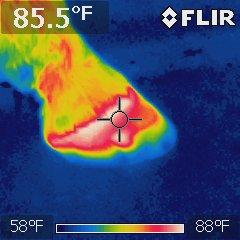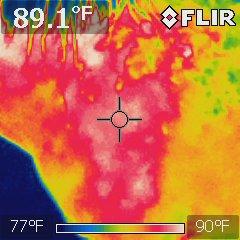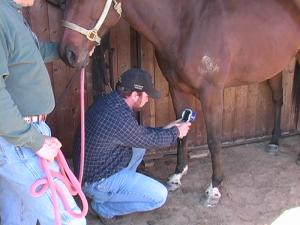By Link Casey; with introduction from Nancy Brannon, Ph.D.
Infrared Thermal Imaging, aka Thermography, is a non-invasive, safe, cost-effective diagnostic imaging tool and is a valuable complementary tool in equine health care. The thermographic camera detects infrared waves on the body surface that are invisible to the human eye and converts them to an image we can see. It is primarily useful in detecting lameness and regions of inflammation in horses. Some units can detect flexor tendon injuries even before the horse develops clinical lameness. Thermography can also be used to monitor the progress of healing.
The uses of Infrared Thermal Imaging technology in the world of equines are numerous. Thermal cameras have been used with equines for many years now, by myself and others. The benefits that have come from thermal imaging cameras are outstanding! I am a farrier of 18 years and I use thermal cameras in all of my daily practices.
As the owner of the Casey Horseshoeing School, in affiliation with the Farriers’ National Research Center, I also use thermal cameras in the teaching process with my students. It has become so simple now to evaluate the horse with thermal technology that it is definitely a “go to” for me. The old saying is “no horse is trimmed or shod better than with the human eye.” But I say, why not make the human eye better [through the use of technology].
Taking half an hour to evaluate the horse by looking, poking, and prodding is a thing of the past. Do I still examine how a horse moves and read the feeling in its face to see how much pain or discomfort it’s in? Of course I do! I always make a visual determination about every horse I see. But with thermal technology, the problems that a horse may have, or not have, can be found to a precise point. Then the proper corrective procedures can be performed, based on actual facts that can be seen, not a just a good educated guess. Following are some examples of the practical application of thermography.
For instance, a horse may develop an abscess, which is one of the most common lameness issues. With thermal imaging, I can determine exactly where the abscess is, pop the abscess to immediately relieve the horse’s discomfort, and have the horse standing in comfort in a matter of a few minutes, rather than spending more time searching for it by using basic hoof testers or other common farrier tools.
The use of thermal devices is not only limited to hoof lameness. As an equine professional, the most popular question I get is about movement problems and saddle fit. When a horse isn't moving properly, the cause is not always found in the feet. Just like so many of us humans pull muscles or have soreness in our muscles, a horse can also have these issues.
If you work a horse every day for a week without the proper warm up and flexing period, the horse may pull a muscle in the shoulder, back, or the hip – or have general soreness in these or other areas.
A thermal scan can show exactly where the inflamed area is and then the proper recovery procedures can take place. So many problems I see with soreness in the horse are related to the saddle. If your saddle doesn’t fit the horse properly, you are going to have problems with that horse. A 200-lb. person on a horse with a poorly fitted saddle is the like a human carrying a poorly fit backpack: it’s going to cause soreness somewhere. Thermal scans of the horse’s back, after the saddle has been cinched and sat in, will show precisely what pressure points are causing a movement issue in the horse.
Thermal imaging technology is not just a luxury for the high-end performance horse. In my opinion, it should be used on every horse, from the common trail horses to most prestigious show horses. If you have strong consideration for your horse, thermal imaging technology will benefit them in every viable way to keep them comfortable and living a long happy life.
A Happy Horse = A Happy Owner!
About the author: Link Casey is owner, son, and Instructor at Casey & Son Horseshoeing School & Clinic, LLC and the Farriers’ National Research Center. He is a Certified Master Farrier and Master Educator.
Editor’s note: additional articles on thermography
Eddy, A.L., L.M. Van Hoognoed, J.R. Shyder. 2001. “The Role of Thermography in the Management of Equine Lameness.” The Veterinary Journal (Vol. 162 #3) November. https://www.sciencedirect.com/science/article/pii/S1090023301906185
Nexxis. “Equine Clinic Enhanced with Thermal Imaging Camera.” https://nexxis.com.au/equine-clinic-enhanced-with-thermal-imaging-camera/
Robson, Joanna L., DVM. 2017. “Equine Thermography. The Horse. January. https://thehorse.com/114232/equine-thermography/
Robson, Joanna L., DVM. 2010. “Horses In Color: The Role of Thermal Imaging in the Equine Industry.” IR Industry News. March. https://irinfo.org/03-01-2010-robson/
Von Schweinitz, Dietrich Graf, BSc, DVM, MRCVS. “Thermographic Diagnostics in Equine Back Pain. https://www.researchgate.net/profile/Dietrich_Graf_von_Schweinitz/publication/13080649_Thermographic_Diagnostics_in_Equine_Back_Pain/links/5ca4cd27458515f785220c28/Thermographic-Diagnostics-in-Equine-Back-Pain.pdf
Infrared Thermal Imaging, aka Thermography, is a non-invasive, safe, cost-effective diagnostic imaging tool and is a valuable complementary tool in equine health care. The thermographic camera detects infrared waves on the body surface that are invisible to the human eye and converts them to an image we can see. It is primarily useful in detecting lameness and regions of inflammation in horses. Some units can detect flexor tendon injuries even before the horse develops clinical lameness. Thermography can also be used to monitor the progress of healing.
The uses of Infrared Thermal Imaging technology in the world of equines are numerous. Thermal cameras have been used with equines for many years now, by myself and others. The benefits that have come from thermal imaging cameras are outstanding! I am a farrier of 18 years and I use thermal cameras in all of my daily practices.
As the owner of the Casey Horseshoeing School, in affiliation with the Farriers’ National Research Center, I also use thermal cameras in the teaching process with my students. It has become so simple now to evaluate the horse with thermal technology that it is definitely a “go to” for me. The old saying is “no horse is trimmed or shod better than with the human eye.” But I say, why not make the human eye better [through the use of technology].
Taking half an hour to evaluate the horse by looking, poking, and prodding is a thing of the past. Do I still examine how a horse moves and read the feeling in its face to see how much pain or discomfort it’s in? Of course I do! I always make a visual determination about every horse I see. But with thermal technology, the problems that a horse may have, or not have, can be found to a precise point. Then the proper corrective procedures can be performed, based on actual facts that can be seen, not a just a good educated guess. Following are some examples of the practical application of thermography.
For instance, a horse may develop an abscess, which is one of the most common lameness issues. With thermal imaging, I can determine exactly where the abscess is, pop the abscess to immediately relieve the horse’s discomfort, and have the horse standing in comfort in a matter of a few minutes, rather than spending more time searching for it by using basic hoof testers or other common farrier tools.
The use of thermal devices is not only limited to hoof lameness. As an equine professional, the most popular question I get is about movement problems and saddle fit. When a horse isn't moving properly, the cause is not always found in the feet. Just like so many of us humans pull muscles or have soreness in our muscles, a horse can also have these issues.
If you work a horse every day for a week without the proper warm up and flexing period, the horse may pull a muscle in the shoulder, back, or the hip – or have general soreness in these or other areas.
A thermal scan can show exactly where the inflamed area is and then the proper recovery procedures can take place. So many problems I see with soreness in the horse are related to the saddle. If your saddle doesn’t fit the horse properly, you are going to have problems with that horse. A 200-lb. person on a horse with a poorly fitted saddle is the like a human carrying a poorly fit backpack: it’s going to cause soreness somewhere. Thermal scans of the horse’s back, after the saddle has been cinched and sat in, will show precisely what pressure points are causing a movement issue in the horse.
Thermal imaging technology is not just a luxury for the high-end performance horse. In my opinion, it should be used on every horse, from the common trail horses to most prestigious show horses. If you have strong consideration for your horse, thermal imaging technology will benefit them in every viable way to keep them comfortable and living a long happy life.
A Happy Horse = A Happy Owner!
About the author: Link Casey is owner, son, and Instructor at Casey & Son Horseshoeing School & Clinic, LLC and the Farriers’ National Research Center. He is a Certified Master Farrier and Master Educator.
Editor’s note: additional articles on thermography
Eddy, A.L., L.M. Van Hoognoed, J.R. Shyder. 2001. “The Role of Thermography in the Management of Equine Lameness.” The Veterinary Journal (Vol. 162 #3) November. https://www.sciencedirect.com/science/article/pii/S1090023301906185
Nexxis. “Equine Clinic Enhanced with Thermal Imaging Camera.” https://nexxis.com.au/equine-clinic-enhanced-with-thermal-imaging-camera/
Robson, Joanna L., DVM. 2017. “Equine Thermography. The Horse. January. https://thehorse.com/114232/equine-thermography/
Robson, Joanna L., DVM. 2010. “Horses In Color: The Role of Thermal Imaging in the Equine Industry.” IR Industry News. March. https://irinfo.org/03-01-2010-robson/
Von Schweinitz, Dietrich Graf, BSc, DVM, MRCVS. “Thermographic Diagnostics in Equine Back Pain. https://www.researchgate.net/profile/Dietrich_Graf_von_Schweinitz/publication/13080649_Thermographic_Diagnostics_in_Equine_Back_Pain/links/5ca4cd27458515f785220c28/Thermographic-Diagnostics-in-Equine-Back-Pain.pdf












